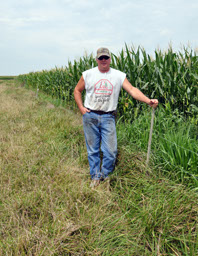|
|
Ray Menke of rural Fort Madison admits the main reason he switched to no-till farming in 1987 was his inability to afford new expensive farm equipment and machinery.
Now, 25 years later, Menke is still leaving the soil undisturbed and he’s reaping the benefits during this year’s extreme drought.
Menke says he doesn’t know exactly how his 600 acres of corn and soybeans will yield this year, but if history is any indication, his no-till system will be helped by better soil conditions compared to farmers who perform tillage.
“In the bad-weather years, our yields always seem to be better — particularly on marginal ground,” he said.
Rick Bednarek, state soil scientist for USDA’s Natural Resources Conservation Service (NRCS) in Iowa, says Menke is benefitting from high organic matter content in the soil from years of non-disturbance.
“Soil left undisturbed for several years becomes more tolerant to weather extremes,” he said. “The organic matter in undisturbed soil contains more moisture for plant use when rainfall totals are lower than normal. Conversely, healthy soil has the structure that allows excess water to infiltrate into the ground more easily.
“Tillage ruins pores in the soil that help it breathe and drain excess water. Tillage disrupts the soil’s natural biological cycles and wrecks the structure of the soil, making it susceptible to erosion."
Menke thinks his annual crop yields are competitive with other farmers in the area. He says the trouble is nobody will tell him.
“Nobody who tills wants to admit to me that they yield 200-bushel corn when I yield the same with fewer inputs,” he said. “I think farmers who till the soil feel pressure to yield 20 bushel more per acre than me. If they aren’t, my net profits are going to be higher than theirs.”
By today’s farming standards Menke relies very little on inputs. He covers many of his fields with dry manure over a 4-year period and applies liquid nitrogen annually in the spring during planting.
He uses 1972 tractor to plant, and he has a few smaller tractors to pull a manure spreader. “
You can no-till with an old tractor with bald tires running half throttle,” says Menke. “We hardly use any fuel. It is benefits like that people don’t understand with no-till.”
Grazing Management
The extra time made available by no-till farming allows Menke to graze cattle as well. He was ahead of his time 20 years ago when he set up a rotational grazing system for his feeder cattle.
His goal was to make better use of his limited forage (75 acres) and grow his herd. His multi-paddock system allowed him to double the size of his herd, from 60 to 120.
Menke says he feels that two decades of successful pasture management is paying off during the drought. His rotational grazing system is also helping to improve soil health. When livestock move from paddock to paddock, it allows pasture plants to rest and regrow.
“Neighbors are feeding hay to supplement grass,” he said. “I still have three paddocks left and we pulled off 40 big round bales just the other day.”
Menke recently purchased another farm where he will more intensely graze a cow/calf herd in smaller paddocks, rotating them more often. “To me, the grass just grows much better when they’re not in a paddock for days or weeks at a time,” he said. “What little rain we’ve received this summer really brings the grass around in a hurry.”
Rewarded for Stewardship
In 2010, Menke was rewarded for his longtime conservation ethic with a contract through the USDA-administered Conservation Stewardship Program (CSP), which provides financial and technical assistance to help land stewards further conserve and enhance soil, water, air, and related natural resources on their land. CSP gives credit for past stewardship and encourages producers to address resource concerns by undertaking additional conservation activities and improving and maintaining existing conservation systems.
Menke will use his CSP contract to enhance his operation in two ways:
1. To utilize electronically-controlled (GPS) technology to more precisely apply agricultural pesticides.
2. To help implement his new intensive management grazing system.
TJ Mathis, district conservationist for NRCS in Lee County, says Menke has done a lot of other conservation work on his farms – the majority of it on his own.
“I have worked with Ray on different projects, including terraces, pasture management, and watershed structures,” said Mathis. “Ray is an innovator. It is easy to see that he has a strong conservation ethic and he is always thinking of the next activity to take his farming and conservation to the next level.”
For more information about conservation planning and programs to help protect the natural resources on your land, visit your local NRCS office or go to www.ia.nrcs.usda.gov.

 Ray Menke, Iowa no-tiller (NRCS photo)
Ray Menke, Iowa no-tiller (NRCS photo)




Post a comment
Report Abusive Comment